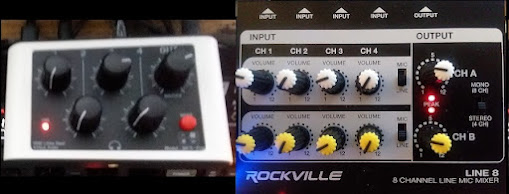I've written ad-nauseam about Stereo-CW and its many variants, which now include Stereo-SSB,
as well as Stereo-RTTY. Spending what seems like HOURS knob-twiddling the filters behind the "Stereo" concept has led me to discover numerous nuances about maximizing our aural-capabilities.
In a recent on-air chat w/John (K3MAH), he mentioned that he has been experimenting w/what
I will call "Stereo-SDR". As I understand it, running 2-computers, each CPU is web-navigated to
a specific pair of WEB SDR's, sending the audio from "Computer #1" to the Left Ear, while the audio from Computer #2 to the right ear. As Thursday net control for the 11am PARS Net (7.245) he has found SDR-supplementation to be more efficacious in making marginal signals overall become briefly intelligible. Of course, RELAY operators are a form of "SDR" as well.
I will call "Stereo-SDR". As I understand it, running 2-computers, each CPU is web-navigated to
a specific pair of WEB SDR's, sending the audio from "Computer #1" to the Left Ear, while the audio from Computer #2 to the right ear. As Thursday net control for the 11am PARS Net (7.245) he has found SDR-supplementation to be more efficacious in making marginal signals overall become briefly intelligible. Of course, RELAY operators are a form of "SDR" as well.
Replicate the above concept on your end and then "play around" with the interplay between the
two SDR's. Because most SDR's also sport a "waterfall"-style of display, you experience the added benefit of visual representation, not only of the signal itself, but of the frequency space right around it.
two SDR's. Because most SDR's also sport a "waterfall"-style of display, you experience the added benefit of visual representation, not only of the signal itself, but of the frequency space right around it.
I thought of replicating the above idea using a specially devised audio cable,
as I have done to run a pair of LEKATO JA-02II mini guitar amp speakers.
as I have done to run a pair of LEKATO JA-02II mini guitar amp speakers.
Turns out, a bringing two ideas together approach is to spend "$19.95" and pick up a USB-powered 4-channel stereo mixing unit (dozens are available on eBay), offering full control over the audio arrangement. The best arrangement for the 4-channels seems to be:
- a 2nd RX (RX-A) - or VFO-B for Dual-RX transceivers
- LEFT SDR #1 Audio
- Main Transceiver [stereo] audio (VFO-A)
- RIGHT SDR #2 Audio
Channels 1 & 3 (across the top) enable mixing receive audio from the transceiver's VFO-B or a 2nd (separate) receiver and the transceiver's VFO-A. Channels 2 & 4 (across the bottom) enable mixing from the SDR audio. Technically, this is NoT truly Stereo-SDR, it is simply a glorified arrangement
for mixing radio and SDR audio.
The TRUE Stereo approach requires creating a special cable for each SDR, feeding SDR#1 ONLY
to the Left Channel and feeding SDR#2 ONLY to the Right Channel. This can be relatively easily accomplished by "doctoring" a pair of patch cables to separate stereo audio to/from each side.
- For SDR #1 (Left-side) clip the red wire (right channel) from the destination plug
and short it to the white wire. - For SDR #2 (Right-side) clip the white wire (left channel) from the destination plug
and short it to the red wire.
Now, when you adjust the SDR mixing level (Channel-2 or Channel-4) you are increasing the SDR signal mixing for JUST the left or right ear. You could even go so far as to run the cables through
a pair of SPDT switches (one for each SDR cable) to keep it all stereo or to create the above scenario.
a pair of SPDT switches (one for each SDR cable) to keep it all stereo or to create the above scenario.
You'll notice that in the header photo I also show a Rockville mixer. In my arrangement, the output
of the USB mixer routes to a splitter box, allowing the ability to run the resulting audio to one or more external filter (combinations) individually. The output of those filters can then be recombined and
sent to speakers and or stereo headphones. Remember: for WQ6X, the Stereo Audio concept
began with a PAIR of Autek QF-1A op-amp based analog audio filters.
of the USB mixer routes to a splitter box, allowing the ability to run the resulting audio to one or more external filter (combinations) individually. The output of those filters can then be recombined and
sent to speakers and or stereo headphones. Remember: for WQ6X, the Stereo Audio concept
began with a PAIR of Autek QF-1A op-amp based analog audio filters.
Basically, what I have described above is really all we need to include this miraculous
Stereo-SDR method as a part of the WQ6X Stereo Audio family.
Stereo-SDR method as a part of the WQ6X Stereo Audio family.
What about YOU?
Do you make use of internet SDR receive facilities?
Have you ever played with stereo audio?
Have you ever played with stereo audio?
What about the Two TOGETHER?




No comments:
Post a Comment